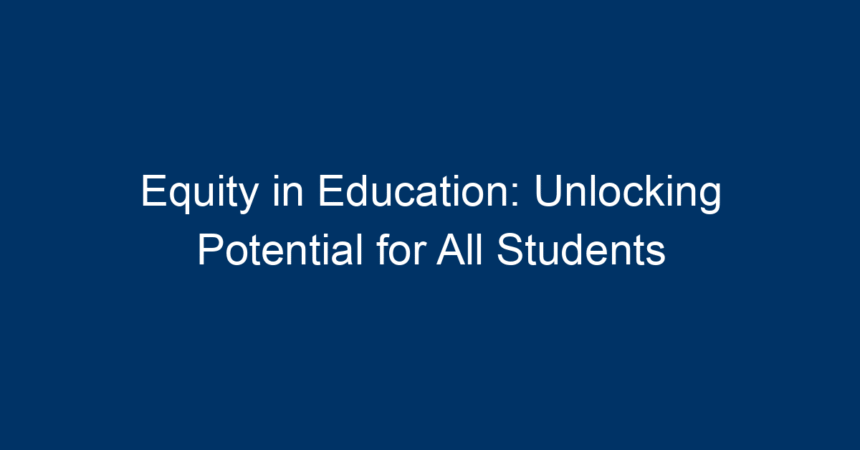In today’s rapidly changing world, education remains one of the most powerful tools for creating opportunities and fostering social mobility. However, not all students have equal access to quality education. This disparity raises a crucial question: How can we achieve equity in education to ensure that every student—regardless of their background—can reach their full potential? This article will delve into what equity in education means, why it matters, and how we can work together to create a more inclusive educational landscape.
What Is Equity in Education?
Equity in education refers to the principle that all students should have access to the same quality of educational resources and opportunities, tailored to their individual needs. Unlike equality, which focuses on uniform distribution of resources, equity recognizes that some students may require additional support to overcome barriers imposed by socioeconomic status, race, or disability.
Importance of Equity in Education
The importance of equity in education cannot be overstated. Research shows that when equitable systems are in place, students perform better academically, socially, and emotionally. When all students are given the resources they need to succeed, society as a whole benefits from a more educated and skilled workforce, reduced crime rates, and improved public health outcomes.
Economic Benefits
Investing in equity in education is not just a moral imperative; it’s an economic one. A well-educated populace contributes to national productivity and innovation. According to studies, every additional year of schooling can increase a person’s earnings by up to 10%. Therefore, when we foster an equitable educational environment, we enhance the nation’s economic potential.
The Barriers to Achieving Equity in Education
Despite the clear benefits of equity in education, several barriers hinder progress toward this goal. Understanding these obstacles is crucial for developing effective strategies to overcome them.
Socioeconomic Status
Students from low-income families often face a range of challenges that impede their educational success. Limited access to educational resources, such as books, technology, and extracurricular programs, can dramatically affect a student’s learning experience.
Racial and Ethnic Disparities
Racial and ethnic minorities often encounter systemic biases within the education system. These can manifest as lower-quality schools, fewer experienced teachers, and even discriminatory disciplinary practices. These disparities contribute to an ongoing achievement gap between different demographic groups.
Disability and Special Needs
Students with disabilities require tailored educational approaches to thrive. However, inadequate funding and resources for special education can leave these students at a significant disadvantage, further perpetuating inequities.
Real-World Applications of Equity in Education
To bridge these gaps, educational institutions must adopt a multifaceted approach. Here are some effective strategies:
Culturally Responsive Teaching
Culturally responsive teaching is an instructional method that acknowledges and incorporates the cultural backgrounds of students into the curriculum. By doing so, educators can create a more inclusive learning environment that validates students’ identities and experiences.
Equity-Based Funding Models
Adopting funding models that allocate resources based on student needs—rather than property taxes—can help ensure that all schools have the necessary tools to provide quality education. This approach can help level the playing field for underfunded schools.
Comprehensive Support Services
Implementing comprehensive support services, including counseling, mentorship, and tutoring, can make a significant difference in student success. Schools should not only focus on academic performance but also provide emotional and psychological support.
Community and Family Engagement
Community and family engagement are critical components of fostering equity in education. When families and communities are involved in the educational process, students are more likely to succeed.
Building Partnerships
Schools can partner with community organizations to provide resources and support to underserved families. Initiatives like after-school programs, food drives, and mental health workshops can make a considerable impact.
Empowering Parents
Empowering parents through workshops and training can enhance their ability to support their children’s education. When families understand the educational system, they are better equipped to advocate for their children’s needs.
The Role of Technology in Achieving Equity
Technology can play a transformative role in achieving equity in education. Online resources and adaptive learning technologies can provide personalized learning experiences, enabling students to learn at their own pace and style.
Addressing the Digital Divide
Despite the promising role of technology, the digital divide remains a significant concern. Many low-income families lack access to reliable internet and devices. Closing this gap should be a priority in any strategy aimed at achieving equity in education.
Leveraging Educational Platforms
Educational platforms that offer free resources can serve as valuable tools for teachers and students alike. By using such platforms, teachers can implement innovative teaching methods, and students can access additional learning materials outside the classroom.
Actionable Insights
To move toward greater equity in education, individuals, educators, and policymakers need to take actionable steps. Here are some practical suggestions:
-
Advocate for Policy Changes: Engage with local and national representatives to push for policies that support equitable funding and access to resources.
-
Participate in Training: Educators should seek ongoing professional development in culturally responsive teaching strategies.
-
Support Local Initiatives: Get involved with local organizations or schools that promote equity and inclusion.
-
Promote Open Communication: Encourage dialogue among educators, parents, and students to identify and address barriers to educational success.
- Utilize Available Resources: Take advantage of online tools and community programs designed to enhance learning opportunities.
Conclusion
Equity in education is not merely a lofty ideal; it is a necessary framework for ensuring that every student can achieve their full potential. By understanding the barriers to equity and implementing actionable strategies, we can create an educational landscape that is truly inclusive. When we unlock the potential of all students, we not only enrich their lives but also strengthen society as a whole. The journey toward equity in education is ongoing, but as we work together, the possibilities are limitless. Let’s champion this cause and ensure that every student’s future is bright.




